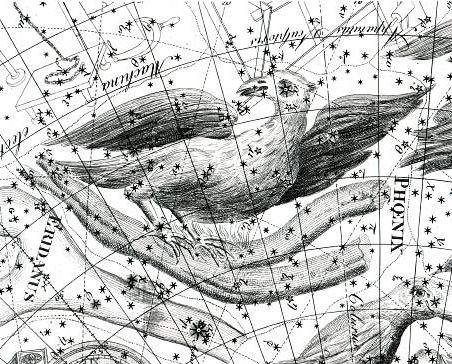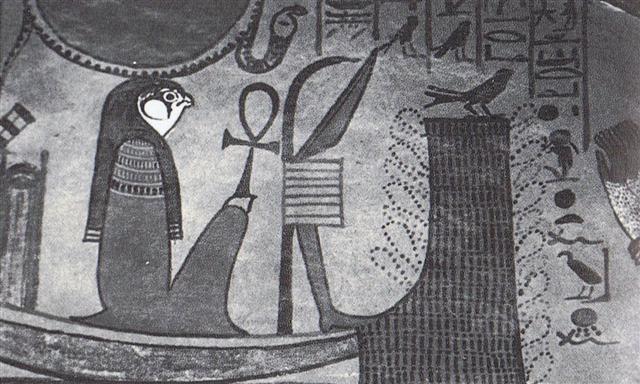4. This is the picture of Pisces according to Flamsteed:
Time zero is here defined to be immediately after the end of the tail of the early fish, putting it securely in the year which is old and needs to be reborn. In order to interpret the meaning of the constellations we have to consider the effects of precession, it cannot be avoided. When the early fish gradually moves to later and later positions in the year it will sooner or later become obvious that the era of Pisces is over. When the pentagon of the early fish no longer lies in the old year we must change to the era of Aquarius. If we look back in time, we should find remnants of ancient constellations which once were used for defining equinox. Perhaps the peculiar curve in the band from Alrisha to the early fish (which cannot be detected on the star map) is a remnant from the curve of Eridanus in front of Cetus. The same curve is also drawn in the version of Urania's Mirror. Earlier I have suggested a curve could be a sign of 'close to the end' and maybe it was an 'international' convention. Allen has interesting information regarding the constellation Phoenix which is rising before Eridanus:
"Phoenix, the French Phénix, the German Phönix, and the Italian Fenice, is one of Bayer's new figures, between Eridanus and Grus, south of Fornax and Sculptor, - its α, κ, μ, β, ν, and γ in a line curving toward the south like that of a primitive Boat, by which figure, as Al Zaurak, the Arabs knew them. Al Sufi cited another name, - Al Ri'āl, the Young Ostriches, - which Hyde wrongly read Al Zibal, perhaps a synonymous title; and Kazwini used Al Sufi's term in describing some stars of Al Nahr, the River, in which our Phoenix was then included by Arabian astronomers. Others changed the figure to that of a Griffin, or Eagle, so that the introduction of a Phoenix into modern astronomy was, in a measure, by adoption rather than by invention. But, whether Bayer knew it or not, his title is an appropriate one, for with various early nations - at all events, in China, Egypt, India, and Persia - this bird has been 'an astronomical symbol of cyclic periods', some versions of the well-known fable making its life coincident with the Great Year of the ancients beginning at noon of the day when the sun entered among the stars of Aries; and, in Egypt, with the Sothic Period when the sun and Sirius rose together on the 20th of July. Thompson further writes of this: A new Phoenix period is said to have commenced A.D. 139, in the reign of Antoninus Pius; and a recrudescence of astronomical symbolism associated therewith is manifested on the coins of that Emperor. Coincidently, Ptolemy adopted as the epoch of his catalogue the year 138, the first of Antoninus. With the Egyptians, who knew this bird as Bennu and showed it on their coins, it was an emblem of immortality; indeed it generally has been such in pagan as well as Christian times ..." I have written earlier (cfr at Aquarius) about the benu and other 'fire birds'. This is how Bode imagined it:
Perhaps the fire bird was depicted as a Swallow in Babylonia:
The cleft branch in Bode's version could be related to the similar Y-form ending in Swallow and in the fish of Anunitum. Looking at the Babylonian drawing we can see that both the bird and the fish have tails, furthermore that the wings of the bird surely must correspond to the fins of the fish. And they both lay eggs: "... Now birds and fishes are born under the sign of the Yin, but they belong to the Yang. This is why birds and fishes both lay eggs. Fishes swim in the waters, birds fly among the clouds. But in winter, the swallows and starlings go down into the sea and change into mussels ..." (Ta Tai Li Chi according Joseph Needham Science and Civilisation in China, vol. 2.) The swallow, I think, is swallowing the Sun in autumn, helping him across the watery region of the sky. Then, rising again from the deepest part the swallow will release him again in spring. Once the swallow was probably a common sign for this phenomenon, it was a kind of phoenix. I have hinted at it in the Kara Etahi chapter: ... To observe stars (excepting Sun of course) we must wait for the night, which also my kara etahi bird explains by holding his wings at the back. His back side represents his manu rere past, and in front lies his daytime, he is a juvenile. His position is therefore quite similar to how the swallow is looking for dawn from the bow of the Sun ship in the dark waters of the night (picture from Wilkinson):
|




